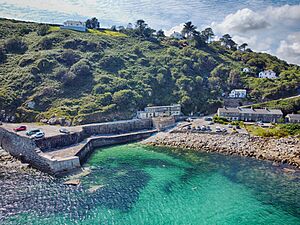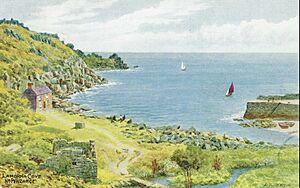Lamorna facts for kids
Quick facts for kids Lamorna
|
|
|---|---|
 Lamorna harbour |
|
| Lua error in Module:Location_map at line 530: Unable to find the specified location map definition: "Module:Location map/data/Cornwall (mainland)" does not exist. | |
| OS grid reference | SW449234 |
| Civil parish |
|
| Unitary authority | |
| Ceremonial county | |
| Region | |
| Country | England |
| Sovereign state | United Kingdom |
| Post town | Penzance |
| Postcode district | TR19 |
| Dialling code | 01736 |
| Police | Devon and Cornwall |
| Fire | Cornwall |
| Ambulance | South Western |
| EU Parliament | South West England |
| UK Parliament |
|
Lamorna (Cornish: Nansmornow) is a small village, valley, and a beautiful cove in west Cornwall, England. It is located on the Penwith peninsula, about 4 miles (6.4 km) south of Penzance. Lamorna is famous for attracting artists from the Newlyn School. Well-known artists like Alfred Munnings, Laura Knight, and Harold Knight lived and worked here. The village is also known for Derek and Jean Tangye, who farmed the land and wrote popular books called "The Minack Chronicles."
Contents
What's in a Name?
The name Lamorna has a long history. It was first written down as Nansmorno in 1305. Over the years, its spelling changed a few times, like Nansmurnou (1309) and Nansmorna (1387). In the Cornish language, Nans means "valley." The second part of the name, mor, likely means "sea." So, Lamorna probably means "valley of the sea."
Exploring Lamorna's Geography
Lamorna Cove is found at the southeastern end of a valley that runs from northwest to southeast. Two large rocks mark the cove: Carn-du (which means "Black Rock") on the east and Lamorna Point on the west. A narrow lane leads down to the car park and quay at the cove. The valley itself, from The Wink public house down to the cove, is privately owned.
The small village of Lamorna is about half a mile inland. It was originally known as Nantewas. The South West Coast Path, a popular walking trail, goes right around the cove. Lamorna is also part of the Cornwall Area of Outstanding Natural Beauty (AONB). This means it has the same special status and protection as a National Park, helping to keep its natural beauty safe.
A Glimpse into Lamorna's Past
People were looking for tin in Lamorna as early as the 1380s. They would collect tin from the stream. You can still see mounds along the stream today, which are signs of this old activity. Kemyel Mill was a working mill for centuries, run by the Hoskyn family from at least the 1300s until the 1920s. Today, it is a gift shop. There were actually two mills here: one ground corn for animals, and the other made flour for people. Both mills are now protected as Grade II listed buildings.
In the 1600s, a privateer ship (a private ship allowed to attack enemy ships) owned by the Penrose family was often kept in the cove. This ship was wrecked during a storm. At one point, five cannons from the wreck were found on the seabed. One of these cannons is now used for underwater archaeology training. Divers also found silver coins from the 1600s near the wreck. Today, the wreck is a popular spot for divers to explore.
A school for young boys and girls opened in Lamorna in March 1881. It could teach fifty to sixty children. Canon Coulson paid for the schoolroom. It could also be used as a church meeting room for Anglicans. Before this school, children had to walk about 4 km to St Buryan for their lessons.
Today, the valley is covered in trees. However, until the 1950s, cows, horses, and pigs grazed on the hillsides and near the stream. Farmers also grew daffodils and early potatoes on the slopes. These flowers were sent to big markets in London, Birmingham, and Wales.
Lamorna's Famous Quarries
You can still see piles of waste rock on the eastern side of the cove. These are reminders of the granite quarries that operated here. John Freeman first opened these quarries in 1849, and they continued working until 1911. Granite from Lamorna was used to build many famous structures. These include the Admiralty Pier at Dover, offices for the London County Council, the Thames Embankment in London, and the Portland Breakwater. Local buildings also used Lamorna granite, such as the Bishop Rock Lighthouse, Mousehole north pier, and the Wolf Rock Lighthouse.
Workers used chains to drag the heavy granite blocks to an iron pier, where the stream meets the sea. From there, the stone was loaded onto ships. A huge stone block weighing 20 tons was even sent by sea to The Great Exhibition in 1851. However, loading ships was risky. So, later, granite was transported by road through Newlyn to cutting yards in Wherrytown. The current quay was built in the late 1800s and is also a protected building.
A quarry on the west side of the cove did not succeed. The granite there had too much quartz, which made it less useful. The Lamorna Cove Hotel, built in the 1870s, was originally the quarry manager's house. It had a school and a chapel for the quarry workers and their families. It became a hotel in the 1920s. During the Second World War, seven French fishing families lived at the hotel. They fished from Newlyn.
Artists and the Lamorna Colony
In the late 1800s and early 1900s, Lamorna became a very popular place for artists from the Newlyn School. It is especially linked to the artist S J "Lamorna" Birch, who lived there from 1908. Other artists who were part of this group, sometimes called the "Lamorna Colony," included Birch, Alfred Munnings, Laura Knight, and Harold Knight.
This artistic period is told in the 1998 book Summer in February by Jonathan Smith. This book was later made into a movie in 2013. Lamorna was also home to the jeweller Ella Naper and her husband, the painter Charles. They built Trewoofe House. The Lamorna Arts Festival started in 2009 to celebrate both the original artists and the art community there today.
Lamorna in Stories and Songs
Lamorna is famous in a folk song called "Way Down to Lamorna." The song is about a husband who gets into trouble with his wife. Many Cornish singers, like Brenda Wootton, love to sing this song.
The actor Robert Newton (1905–1956) went to school in Lamorna. His son, Nicholas Newton, scattered his ashes in the sea off Lamorna.
The writers Derek Tangye and Jean Tangye lived above Lamorna. Derek wrote his well-known books, "The Minack Chronicles," there. A piece of land called "Oliver Land" is now a wildlife sanctuary. It was created to remember the couple. Lamorna was also the setting for Rachel Hore's 2007 novel The Memory Garden. It was also a filming location for Sam Peckinpah's 1971 thriller Straw Dogs. The poem "Lamorna Cove" by W. H. Davies was published in 1929.
Lamorna's pub is called The Wink. Its name hints at smuggling, as "the wink" was a secret signal that illegal goods could be bought. The pub is also the subject of a novel by Martha Grimes, called The Lamorna Wink. Inside the pub, you can see a special collection of items related to the sea.
The Lamorna Pottery was started in 1947 by Christopher James Ludlow (known as Jimmy) and Derek Wilshaw. It is still a working pottery today, with a gift shop and a café.
Images for kids








